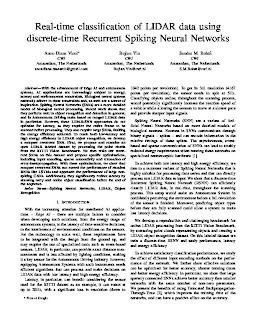2022-09-30
Real-time classification of LIDAR data using discrete-time Recurrent Spiking Neural Networks
Publication
Publication
With the advancement of Edge AI and autonomous systems, AI applications are increasingly subject to energy, latency and environmental constraints. Biological neural systems naturally adhere to these constraints and, as such are a source of inspiration. Spiking Neural Networks (SNNs) are a more detailed model of biological neural processing. Recent work shows that they perform well in object recognition and detection in general, and in Autonomous Driving tasks based on ranged LIDAR data in particular. However, these LIDAR-SNN approaches do not optimize for latency, as they require the entire frame to be scanned before processing. They also require large SNNs, limiting the energy efficiency achieved. To reach both low-latency and high energy efficiency in LIDAR object recognition, we develop a compact recurrent SNN. First, we propose and examine an open LIDAR labeled dataset by processing the point clouds from the KITTI Vision Benchmark. We then train our recurrent SNNs on this dataset and propose specific optimizations, including input encoding, sparse connectivity and truncation of error-backpropagation. With these optimizations, we show that compact recurrent SNNs can exceed the performance of classical RNNs like LSTMs and approach the performance of large non-spiking CNNs. Additionally, they significantly reduce latency by allowing early and online object classification before the end of the sequence.
| Additional Metadata | |
|---|---|
| , , | |
| doi.org/10.1109/IJCNN55064.2022.9892006 | |
| Efficient Deep Learning Platforms | |
| 2022 International Joint Conference on Neural Networks, IJCNN 2022 | |
| Organisation | Centrum Wiskunde & Informatica, Amsterdam (CWI), The Netherlands |
|
Vicol, A.-D., Yin, B., & Bohte, S. (2022). Real-time classification of LIDAR data using discrete-time Recurrent Spiking Neural Networks. In Proceedings of the IEEE International Joint Conference on Neural Networks (pp. 1–9). doi:10.1109/IJCNN55064.2022.9892006 |
|

